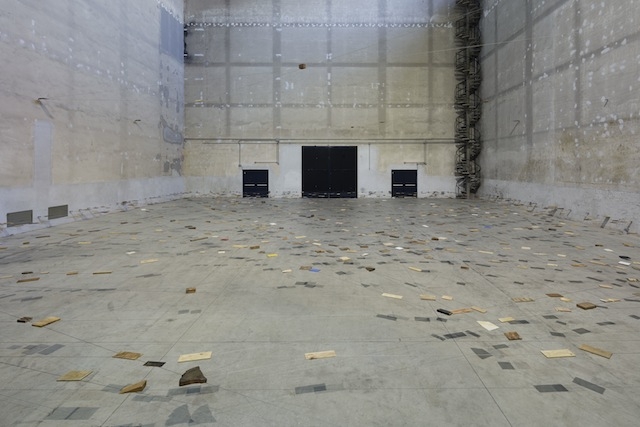Pirelli HangarBicocca, Milan, 30 September – 29 January 2017
The display of Kishio Suga’s retrospective Situations is simple: almost all the 23 sculptures on show (created since 1969 and ‘reactivated’ by the artist for the occasion) rest on the concrete floor of HangarBicocca’s open plan, forming a horizontal continuum interrupted only by the black columns bisecting the space. There are a few notable exceptions to this rule, and they gently press viewers to experience other dimensions of the exhibition space.
At the entrance, Critical Sections (Setsu no rinkai, 1984/2016) runs from ceiling to floor, for over 20 metres: small branches are inserted in a cord of braided white strips of cloth, in order to measure the imposing verticality of this architectural scale. In a corner, Continuous Existence–HB (Renkai–HB, 1977/2016) is a set of forked branches leaning against a white wall: a wiggly line of rope lies atop them and creates a sort of elevated orography, before falling again to the ground to rest in peace. Halfway through the hall, Infinite Situation iii (door) (1970/2016) is a bulky wooden beam wedged diagonally into the only open doorway of the otherwise sealed and dark gallery; outside, the rare trespassers are greeted by Unfolding Field (Noten, 1972/2016), an installation of stone blocks, green plants and bamboo poles dangling in the wind.
At the hangar’s far end, Left-Behind Situation (Shachi Jōkyō, 1972/2016) occupies the whole volume of the Cubo, a cubic barrel-vaulted building, with a web of industrial wire cable – one single cable, over 1km long, stretched across the room and fixed to its concrete walls with bolts and pulleys. Wooden blocks of different shapes and colours are placed atop each point of intersection, so that they seem to float in midair, as if levitating, while shadows crisscross on the ground below. This quiet coup de théâtre, where everything lies in a state of tension and suspension, best embodies the work of Suga, especially here. Left-Behind Situation successfully defines its own perimeter, and carves a silent, undisturbed space of contemplation. Ma – the void, or negative space, or interval that surrounds all things and endows them with a real presence, a cornerstone of Japanese aesthetics – can here deploy its magic, whereas the systematic juxtaposition of works throughout the exhibition generates a taxonomy of shapes, colours and media that subtracts some strength from them.
Suga uses unprocessed materials, both natural and artificial (stones, zinc plates, concrete bricks, grass, plywood, rocks, steel rods, paper), and arranges them in elegant compositions lasting only as long as their appearance in public: each time they are reproduced, the artist introduces some changes. The influence of Buddhist spirituality is evident, so that it’s tempting to read these works as timeless existential metaphors: the ephemerality of all status quo and balance, the recurrence of natural cycles. To me, one of the defining aspects of this show, where little documentation is provided (besides the free booklets) to help the public associate Suga with a precise time, geography, ideological position or modus operandi, is its being constantly lost in translation, from East to West and back again. While studying under Yoshishige Saitō at Tama Art University in Tokyo, during the late 1960s, Suga learned about American Minimalism and got accustomed to the writings of Baudrillard and Deleuze. Like other protagonists of Mono-ha (School of Things) and Italian Arte Povera – the two groups exhibited side by side at the Tokyo Biennale in 1970 – he struggled against the violent colonisation of consumerist society by means of a ‘less is more’ version rooted in his own culture. Besides market pressure, I wonder if Mono-ha’s recent ‘rediscovery’ and success is linked precisely to that refusal of the ‘too much’, to the instant relief provided by enhanced materiality to our post- digital and increasingly disembodied experience of the world.
This article was first published in the December 2016 issue
